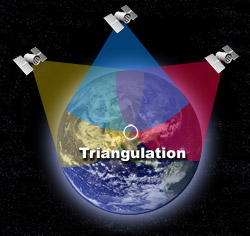
Since the discovery of the famous FTL Neutrinos, the science community has been hard at work trying to either come up with a new theory of relativity, or disprove CERNs findings. Well, mostly the latter. It’s important to state that NOBODY has conclusively done so thus far. There have, however, been a couple of suggestions which I personally found fascinating.
Relativistic Effects of GPS
Dr Ronald van Elburg of the University of Groningen, Netherlands, has recently postulated in a paper that the 60 nanoseconds causing of the scientific headache can be explained by the speed of the satellite systems that have been used to calculate the distance and timing via GPS.
 Satellites orbiting earth do so at speeds of 17,000-30,000 mph, which is pretty damn fast. That isn’t fast enough to cause noticeable time dilation or other relativistic effects in day to day life, but when you’re measuring a travel time of 2.4 milliseconds every little counts. Dr van Elburg’s calculations put the amount of time lost due to relativity from a GPS Satellite at a magical 64 nanoseconds – almost exactly the speed needed to keep Einstein’s theory in tact.
Satellites orbiting earth do so at speeds of 17,000-30,000 mph, which is pretty damn fast. That isn’t fast enough to cause noticeable time dilation or other relativistic effects in day to day life, but when you’re measuring a travel time of 2.4 milliseconds every little counts. Dr van Elburg’s calculations put the amount of time lost due to relativity from a GPS Satellite at a magical 64 nanoseconds – almost exactly the speed needed to keep Einstein’s theory in tact.
While this may sound great, there are a few things to consider which prevent it from being the conclusive debunking that it may seem to be. Firstly, the CERN physicists have said that they have already accounted for all relativistic effects. And while they haven’t listed in detail how they did this, the effect of the satellite motion would be the most obvious thing that they would have already accounted for.
The guys at CERN are, to put it mildly, fairly bright chaps. So for them to have not spotted the most obvious relativistic effect would be unlikely, but not impossible.
Quantum Foam Resistance
This is a theory I heard being discussed between two physicists on a late night science radio show. Their suggestion was a thought experiment only- there was no math done- so I’d add the caveat that this is purely speculation. But it’s damn good speculation nonetheless.
 |
| Visualisation of the quantum foam in the vacuum |
When we refer to ‘c’ (e=mc^2) we refer to the speed of light in a vacuum; the “fastest” speed that light can go at. This is because when light travels through matter (like glass, water, air) its travels slower.
Quantum mechanics has taught us that in reality there is no such thing as true vacuum – absolute nothingness. Even in the depths of space, where there is no gas, no dust, or any other matter, there is ‘stuff’ in the ‘vacuum’. This is known as quantum foam, and is a result of ‘virtual’ particles popping in and out of existence, annihilating almost instantaneously.
So if vacuum isn’t really vacuum, how do we know that the speed of light in a ‘vacuum’ is really the top speed of the universe? Neutrinos are known to be notoriously difficult to impede; to block even 50% of emitted neutrinos, you would need a sheet of solid lead that was light-years thick. So what if we need to swap e=mc^2 to say e=mn^2? This would mean that the initial speed of neutrinos was the cosmic speed limit, explaining why ‘c’ was 60 nanoseconds too slow in the CERN experiments! It’s nothing more than an interesting thought experiment, but it is damn interesting.

No comments:
Post a Comment